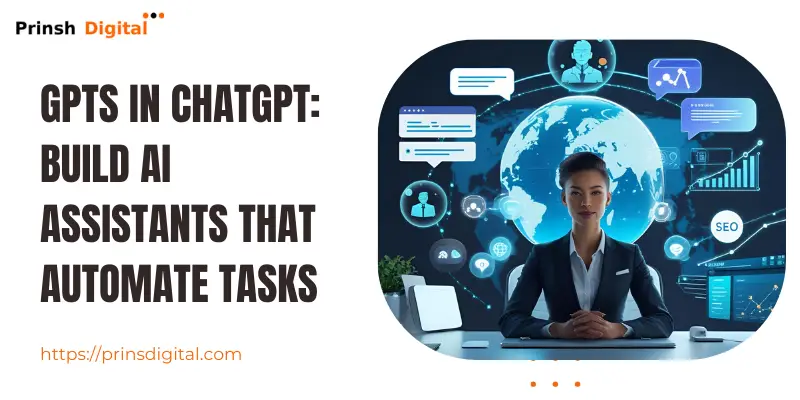In today’s fast moving digital world, staying ahead of the curve is essential. Whether you’re a freelancer, agency owner, startup founder, or scaling brand, the pressure to create consistent content, manage SEO, run campaigns, and respond to customers can quickly become overwhelming. That’s where GPTs in ChatGPT (https://chatgpt.com/gpts) come in.
These aren’t just chatbots. They’re custom-built AI assistants that you can train to automate repetitive tasks like SEO optimization, blog writing, email generation, keyword research, social media content creation, and so much more. And the best part? You don’t need to write a single line of code.
In this in-depth guide, we’ll show you exactly how to build one for your business, even if you’re not tech savvy.
So whether you’re looking to save time, reduce costs, or grow your business globally, GPTs in ChatGPT are the smartest tool you’re probably not using yet.
What Are GPTs in ChatGPT?

Let’s start with the basics.
GPTs (Generative Pre-trained Transformers) in ChatGPT are custom versions of the ChatGPT AI, trained to perform specific tasks or support specific workflows. OpenAI allows users to build their own GPTs—tailored digital assistants that can be integrated into your daily operations.
Think of GPTs as:
- Your virtual marketing assistant
- Your 24/7 customer support agent
- Your content writer, strategist, and data analyst—all in one
Unlike standard AI tools, these GPTs can be fine-tuned with your own instructions, tools, and personality, making them uniquely yours.
Use Case: How GPTs Are Powering Growth
Here at Prins Digital, we recently built a custom GPT for a Blogger. The founder, who had zero technical background, needed help scaling website traffic. We helped him to launch a GPT that:
- Wrote SEO-optimized blog posts
- Generated meta title and descriptions
- Suggested social media captions
- Provided instant responses to FAQs
The result? 42% increase in organic traffic and 30 hours saved each month on repetitive tasks.
💡 Moral of the story? GPTs don’t just work. They work smarter—and they’re here for businesses of all sizes.
Why GPTs Are a Game-Changer for Entrepreneurs
Save Time on Repetitive Tasks
Think blog writing, product descriptions, onboarding documents, email drafts—GPTs can automate these in minutes.
Cut Operational Costs
Instead of hiring a team of content writers or support reps, GPTs can handle 80% of the load at a fraction of the cost.
Make Smarter, Faster Decisions
GPTs can summarize reports, analyze data, and even help write business strategies using your custom guidelines.
Offer 24/7 Customer Support
With integration into your website, GPTs can answer customer queries instantly—boosting trust and sales.
Top GPT Use Cases by Business Type
| Business Type | GPT Use Case |
| eCommerce | Product descriptions, abandoned cart recovery messages, chatbot support |
| Coaches & Consultants | Course content, lead magnets, session recaps |
| Agencies | Proposal templates, client reporting, SOP creation |
| Real Estate | Listing write-ups, contract summaries, local market analysis |
| Freelancers | Portfolio copy, client emails, quote generation |
How to Create a Custom GPT in ChatGPT (No Coding Required)
Creating your own GPT sounds technical but it’s not.
Step-by-Step Process:
- Log into ChatGPT Plus
You’ll need a Plus account to access the GPT builder. - Click “Explore GPTs” > “Create”
This opens the GPT Builder. - Answer a Few Simple Prompts
The builder will ask:- What’s your GPT’s name?
- What’s it designed to do?
- What kind of tone should it have?
- Should it use any specific data or tools?
- Upload Files or Instructions
You can upload documents, brand guides, or link to tools via API. - Test and Iterate
Try different prompts, review outputs, and tweak settings until it feels right.
SEO Benefits of Using GPTs for Content Creation
One of the biggest ROI areas for GPTs? Content.
Here’s what GPTs in ChatGPT can do for your SEO:
- Write SEO-optimized blog posts with target keywords naturally integrated
- Generate meta descriptions, title tags, and H1/H2 structures
- Maintain content freshness with consistent weekly posts
- Create internal link suggestions to improve bounce rate and time-on-page
With a custom GPT, you can build a content engine that feeds your entire funnel from awareness to conversion.
With a custom GPT, you can build a content engine that feeds your entire funnel from awareness to conversion.
Also, read
Best Career Options After Graduation in 2025
On-Page SEO Checklist
How GPTs Enhance Your Website Experience
GPTs can also be embedded into your site as AI chatbots. This enhances user experience by:
- Reducing bounce rate
- Increasing engagement
- Providing instant support or recommendations
- Guiding visitors toward conversion
Imagine a visitor lands on your site and is greeted by a friendly, intelligent GPT that knows your services, values, pricing, and process. That’s instant trust and it converts.
Prins Digital’s Expert Tips: Making Your GPT Stand Out
Give it Personality: Use a voice that matches your brand—professional, quirky, empowering, etc.
Train It with Your Own Materials: Upload PDFs, manuals, blog posts, or guidelines to make it smarter.
Connect It with Tools: Use APIs to link it to Google Sheets, Calendars, Shopify, or CRMs.
Name It Well: The right name gives it identity—like “CopyBot Pro” or “LegalMate AI.”
Update It Monthly: As your business grows, so should your GPT. Keep fine-tuning.
Human Touch + GPT = The Perfect Combo
GPTs should enhance human creativity not replace it. The best results come when you combine AI speed with human strategy.
We recommend:
- Use GPTs for drafts
- Add your personal experience or client stories
- Edit for tone and clarity
- Always double-check facts (especially legal/financial)
SEO Keywords to Use in Your GPT Blog Strategy
Make sure your content includes terms like:
- How to use GPTs for business
- Best custom GPTs
- ChatGPT for entrepreneurs
- AI tools for small business
- ChatGPT marketing strategy
- GPT blog writing assistant
- Build your own GPT
- ChatGPT plugins for business
- OpenAI GPT guide 2025
These keywords not only boost SEO but also match real user intent.
Final Thoughts: The Future Is GPT-Powered
If you’re still thinking about GPTs as “just another tech tool,” it’s time to reconsider. They are the future of lean, scalable business that help you work smarter, not harder.
You don’t need to be a tech guru. You just need to be open to change and have the right team by your side.
Whether you’re a freelancer, small business, or scaling startup, GPTs in ChatGPT offer real, measurable advantages.
Frequently Asked Questions (FAQs) About GPTs in ChatGPT
1. What is a GPT in ChatGPT and how is it different from regular ChatGPT?
A GPT in ChatGPT refers to a customized AI assistant built on top of OpenAI’s large language model. While regular ChatGPT offers general AI responses, GPTs allow users to personalize the assistant by uploading instructions, documents, tone preferences, and connected tools (APIs). These GPTs can handle niche tasks such as content creation, SEO automation, or business consulting making them more task-focused and aligned with your brand.
2. How can GPTs help automate SEO for my website or blog?
GPTs can automate various SEO tasks, including:
- Keyword research and content planning
- Writing meta titles and descriptions
- Generating internal link suggestions
- Producing optimized blog posts and web copy
- Structuring content with proper heading tags (H1, H2, H3)
- Creating schema markup drafts
When trained correctly, a GPT can function like an in-house SEO assistant, saving you hours each week while keeping your content competitive in search rankings.
3. Do I need to know coding to build a custom GPT in ChatGPT?
No coding is required! OpenAI’s no-code GPT Builder allows you to create a GPT by simply answering a series of natural language prompts. You can specify its tone, knowledge base, tools, and use cases. The entire process is designed to be user-friendly, making it accessible even if you have no technical background.
4. Can GPTs write high-quality content for my business blog?
Yes. GPTs can write SEO-optimized, natural-sounding blog content tailored to your industry, tone, and audience. You can instruct your GPT to:
- Follow your brand voice
- Include specific keywords
- Mimic your writing style
- Use customer personas
- Create article outlines and complete posts
You should still review and lightly edit the content to ensure accuracy, especially for legal, medical, or finance topics.
5. What business tasks can GPTs help automate besides content writing?
GPTs can automate a wide variety of tasks such as:
- Drafting emails, proposals, and reports
- Generating product descriptions
- Customer support through chatbot integration
- Translating content for global audiences
- Summarizing meeting transcripts or notes
- Creating social media captions and campaign ideas
They can serve as virtual team members, reducing workload and operational costs.
6. Are GPTs useful for small businesses and solopreneurs too?
Absolutely. In fact, GPTs can be even more beneficial for small teams and solo entrepreneurs who lack time and resources. A well-trained GPT can replace the need for hiring content writers, marketing assistants, or support agents—helping you scale without added payroll. Many solo businesses use GPTs to write newsletters, answer leads, and automate social media posts.
7. Can I train a GPT using my own documents or brand materials?
Yes. You can upload PDFs, brand guides, FAQs, internal SOPs, or web copy to train your GPT. This helps the assistant learn your products, services, tone, and preferences. The more relevant information you provide, the smarter and more customized your GPT will become.
8. How do GPTs help with marketing automation?
GPTs can:
- Write email sequences and lead magnets
- Create ad copy for Google or Facebook Ads
- Generate A/B variations for landing pages
- Provide blog content calendars
- Analyze and rewrite low-performing copy
By reducing time spent on repetitive marketing tasks, GPTs free up your energy for strategy and client work.
9. Can I use GPTs for customer support on my website?
Yes. You can embed a GPT as a chatbot on your site to answer common questions, guide users, provide product recommendations, and even troubleshoot issues. Unlike traditional bots, GPTs are conversational, smart, and context-aware—offering a much better experience for your visitors.
10. Is it safe to use GPTs for business tasks?
Yes, GPTs are safe to use as long as you follow best practices:
- Avoid uploading sensitive customer data
- Use GPTs for drafts and double-check critical info
- Set clear instructions to avoid misinformation
- Train the model responsibly using trusted data
For tasks involving legal, financial, or medical decisions, always consult a certified professional alongside your GPT assistant.
11. How can GPTs support multilingual businesses or global brands?
GPTs are powerful tools for global expansion. They can:
- Translate content into dozens of languages
- Localize marketing materials for different cultures
- Support multilingual customer queries
- Write blog posts optimized for international SEO
This makes GPTs ideal for brands scaling across borders, marketplaces, and global markets.
12. Can GPTs connect with tools like Notion, Shopify, or Google Sheets?
Yes. GPTs built with tool integrations (through APIs or plugins) can connect with:
- Google Sheets (data entry, summarization)
- Notion (SOP updates, content storage)
- Shopify (product uploads, customer FAQs)
- Zapier for automating multi-step workflows
This makes your GPT more than a content tool—it becomes a business operations assistant.
13. How often should I update or retrain my GPT?
It’s smart to review and retrain your GPT monthly especially if your business offerings, tone, or strategy changes. Regular updates help your GPT stay aligned with your goals, seasonal content, and evolving brand language. If you upload new materials like case studies or service guides, always update your GPT’s training data.
14. Can a GPT help me with keyword research and content strategy?
Yes! A properly trained GPT can:
- Suggest high-value keywords and long-tail phrases
- Build topic clusters for your blog
- Organize pillar pages and supporting articles
- Create weekly or monthly content calendars
- Analyze competitors’ content gaps
This makes GPTs extremely valuable for SEO consultants, content marketers, and business owners who want organic growth without expensive tools.
15. How do I get started with building my own GPT?
To build your own GPT:
- Log into ChatGPT (Plus plan required)
- Click “Explore GPTs” → “Create”
- Describe your GPT’s name, goals, tone, and expertise
- Upload brand materials and docs
Test and tweak its behavior until it fits your use case



